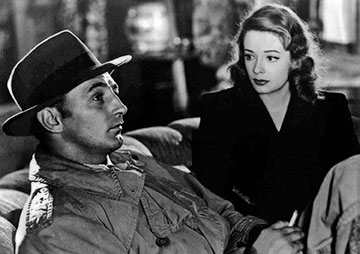 Humanities
Humanities
Going To The Dark Side

There are femmes fatales, and then there is Kathie Moffat in Out of the Past.
The femme fatale—French for “fatal woman”—is a stock character from the heyday of film noir after World War II. Mysterious and seductive, she uses her charms to ensnare her lovers and lead them into trouble, in movies known for their bleak, pessimistic tone.
Arguably, no one was more lethal than Moffat—portrayed by Jane Greer—in the 1947 film noir classic. Playing opposite Robert Mitchum’s “Jeff Bailey” (above), she shoots dead two people and also kills Bailey and herself in a car crash. For good measure, she was also a suspected thief.
UO junior Brennan Heller loves Moffat. Not love in the romantic sense, mind you; he loves what the character shows us about the rising power of women—and its effect on men—after World War II.
Heller is enrolled in the Clark Honors College, which requires students to take a research course in either history or literature. But as a major in both psychology and business administration, he was forced to stretch academically to meet this obligation. Fortunately, he found an English course that aligned with a personal interest: as a movie buff, he zeroed in on a class about the literature of film.
That was the easy part. More daunting was the prospect of completing, over the 10-week span of the course, a probing critique on a film genre that experts have already studied exhaustively.
The requirement for developing an original angle was stressful, but Heller had a helping hand in adjunct instructor Ulrick Casimir. A specialist in film noir, Casimir tipped Heller off to something that inspired the young researcher: even the experts don’t know everything.
There are plenty of questions that top academics in their fields still can’t answer, Casimir told Heller, so the best place to start is with your own curiosity. During discussions on the project, Casimir repeatedly encouraged his student by asking, “What do you think?”
Casimir and Heller developed a premise—that the anxieties of a post-WWII America fed the film noir genre—and a plan for supporting it with a substantial number of concrete examples. Heller plunged in, reading works including Mark Conard’s The Philosophy of Film Noir and Judith Doneson’s The Holocaust in American Film and watching film noir, both classic (Out of the Past) and contemporary (Carlito’s Way, Chinatown).
 In his paper, Heller (left) notes that veterans came home from war to find that their wives and girlfriends had kept their nations running by joining the workforce, and many of these women resisted resuming their traditional roles. Men were “troubled” and “conflicted” as a result, Heller writes, and these insecurities started playing out, in an indirect fashion, on movie screens, in story lines about scheming temptresses who ultimately are punished for their misdeeds (or, as in Out of the Past, take everyone down with them).
In his paper, Heller (left) notes that veterans came home from war to find that their wives and girlfriends had kept their nations running by joining the workforce, and many of these women resisted resuming their traditional roles. Men were “troubled” and “conflicted” as a result, Heller writes, and these insecurities started playing out, in an indirect fashion, on movie screens, in story lines about scheming temptresses who ultimately are punished for their misdeeds (or, as in Out of the Past, take everyone down with them).
“The misogynistic feelings expressed in noir through the use of the femme fatale,” Heller concludes in his paper, “were a product of the perceived attacks on American masculinity.”
Said Casimir: “Brennan’s tendency to locate hard, material evidence for claims related to thematic concerns makes his work unique.”
And thus the psychology–business administration major has found an unexpected mentor. Even now that the class has ended, “I still talk to him about film,” Heller said.
“I never would have thought college would have been these relationships, where you could meet a professor on common ground about something you like. It was an interactive experience.”
—By Matt Cooper
—Photo credit of film still: CC by SA 2.0


 Twitter
Twitter Facebook
Facebook Forward
Forward